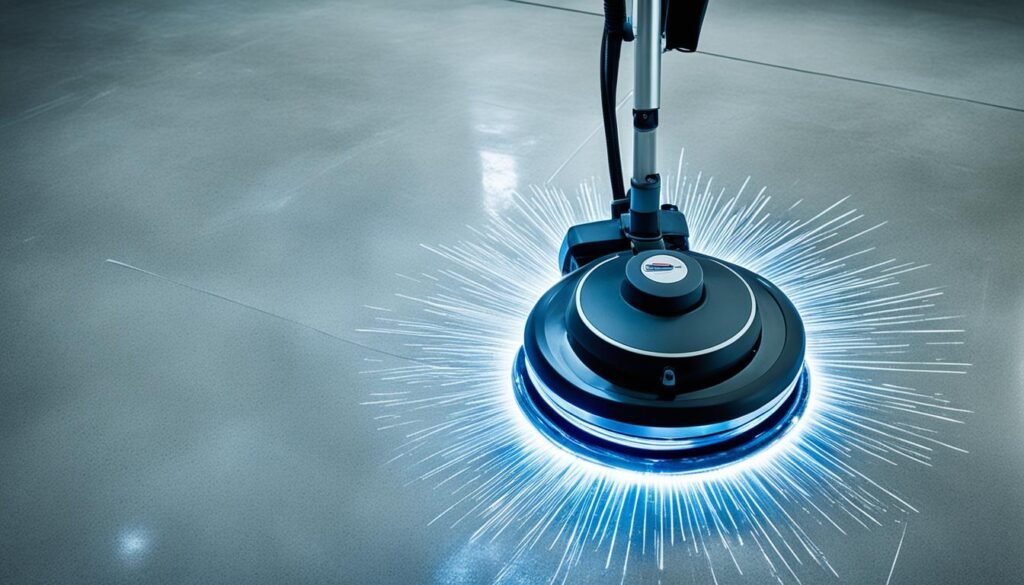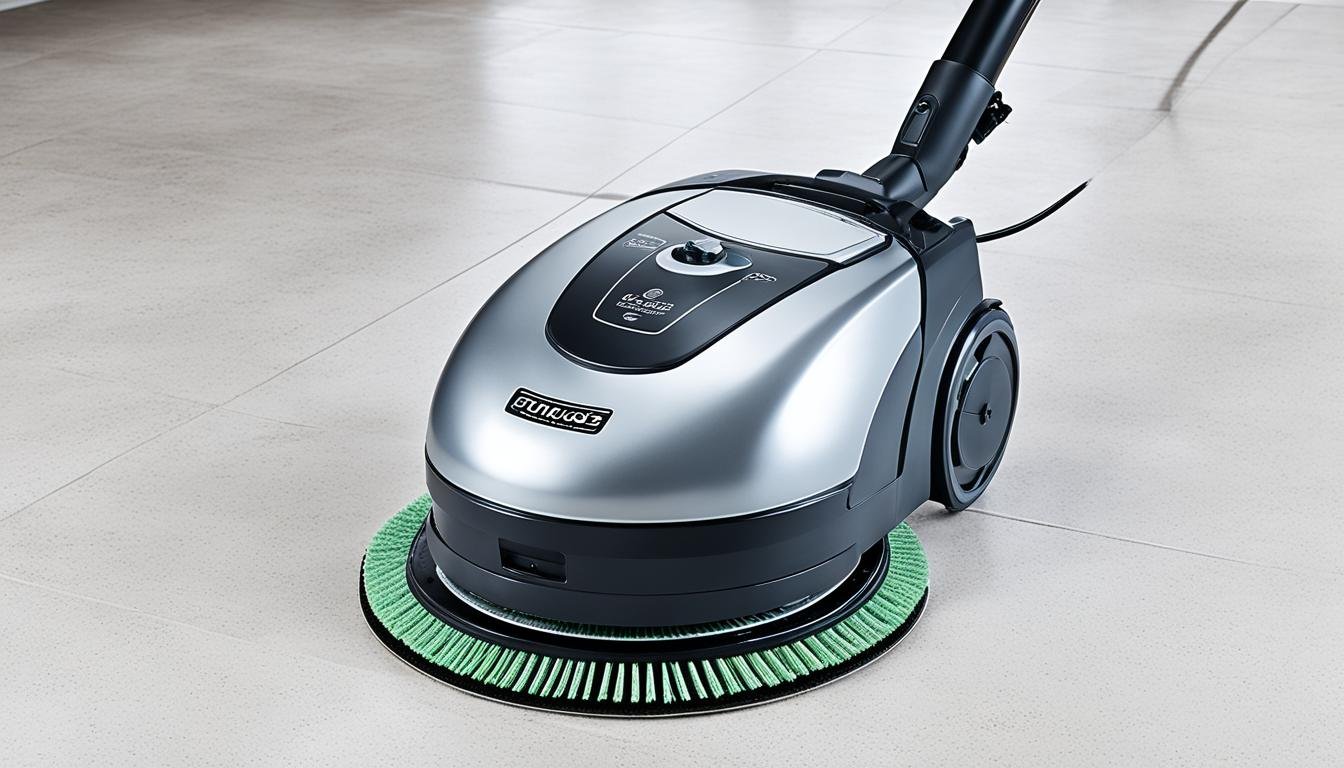When it comes to taking care of your floors, having the right equipment is essential. With a wide range of floor care products available, choosing between a vacuum cleaner and a floor polisher can be a tough decision. Understanding the differences between these cleaning appliances and their specific functionalities is key to making the best choice for your floor maintenance needs.
Key Takeaways:
- There are various types of vacuum cleaners and floor polishers available, each with its own features and benefits.
- Vacuum cleaners excel at removing dirt and debris from different floor surfaces, while floor polishers are designed to give your floors a polished, glossy finish.
- Consider your specific cleaning requirements, type of flooring, and personal preferences when choosing between a vacuum cleaner and a floor polisher.
- Reading vacuum cleaner reviews and comparing floor polishers can help you make an informed decision.
- Maintaining and caring for your floors is crucial to ensure their longevity and appearance.
Understanding Vacuum Cleaners: Types and Features
When it comes to choosing a vacuum cleaner, it’s important to understand the different types available and their unique features. Here, we will explore the two main types of vacuum cleaners: upright and canister, and compare their functionalities. We will also discuss the important factors to consider, such as cleaning requirements and the type of carpet fibers or rugs in your home.
Types of Vacuum Cleaners
In the world of vacuum cleaners, there are two main types: upright and canister vacuum cleaners. Let’s take a closer look at each type:
- Upright Vacuum Cleaners: Popular in the US and Great Britain, upright vacuum cleaners are known for their user-friendly design and powerful suction capabilities. They stand upright and feature a cleaning head at the base with a handle attached. Uprights are particularly effective at cleaning synthetic carpeting and often come with attachments for versatile cleaning on different surfaces.
- Canister Vacuum Cleaners: Preferred in Europe and other parts of the world, canister vacuum cleaners consist of a canister unit that houses the motor and a separate cleaning head attached to a wand. This design offers increased maneuverability and versatility, making canisters highly efficient on various floor surfaces. They are especially useful for cleaning stairs, upholstery, and hard-to-reach areas.
Bag vs. Bagless Vacuums
One key consideration when choosing a vacuum cleaner is whether to opt for a bagged or bagless model. Here’s a comparison between the two:
| Bagged Vacuum Cleaners | Bagless Vacuum Cleaners |
|---|---|
| Require regular bag replacement | No bags to replace, but need filter maintenance |
| Retain allergens and dust inside the bag | Easy to empty and see when it’s full |
| Suitable for individuals with allergies or asthma | More environmentally friendly |
Cleaning Requirements and Carpet Fibers
When selecting a vacuum cleaner, it’s essential to consider your specific cleaning requirements and the type of carpet fibers or rugs in your home. Different types of carpet fibers require different cleaning techniques and levels of care to avoid damage. Here’s a quick overview of common carpet fibers:
- Synthetic Fibers: Synthetic fibers like nylon and polyester are durable and can handle aggressive vacuuming. They are resistant to stains and fading, making them a popular choice for households with high foot traffic.
- Natural Fibers: Natural fibers, such as wool or cotton, require more gentle cleaning to avoid fiber damage. Wool, in particular, is sensitive to heat and can shrink if exposed to high temperatures.
- Oriental Rugs: Oriental rugs, with their intricate designs and delicate fibers, require extra care during vacuuming. It’s recommended to use canister vacuum cleaners with adjustable suction and avoid using rotating brushes that can potentially damage the fibers.
Understanding the cleaning requirements and the type of carpet fibers or rugs in your home will help you choose the right vacuum cleaner that will efficiently clean while preserving the quality and longevity of your floors and carpets.
With the knowledge of different vacuum cleaner types, features, and considerations, you can now make a more informed decision when choosing the best vacuum cleaner for your cleaning needs.
Exploring Floor Polishers: Benefits and Considerations
Floor polishers, also known as floor buffers, are essential tools for achieving a high-gloss shine on your floors. Whether you have hardwood, tile, or laminate flooring, a floor polisher can transform the appearance of your space. Let’s take a closer look at the different types of floor polishers and important factors to consider before making a purchase.
Types of Floor Polishers
When it comes to floor polishers, there are two primary types: rotary floor polishers and oscillating floor polishers.
1. Rotary floor polishers: These machines use a circular motion to scrub and polish the floor surface. They are ideal for removing stubborn dirt and stains, and they offer excellent versatility for both commercial and residential use.
2. Oscillating floor polishers: These floor polishers move back and forth, mimicking the motion of manual polishing. They are well-suited for delicate floor surfaces and provide a light and gentle touch. As a result, they are often recommended for homes with delicate or sensitive flooring.
Factors to Consider
Before investing in a floor polisher, there are several factors you should consider:
- Cleaning Techniques: Evaluate your cleaning techniques and determine if a rotary or oscillating floor polisher is better suited for your needs.
- Maintenance: Consider the maintenance requirements of the floor polisher and ensure it aligns with your cleaning routine and capabilities.
- Cleaning Frequency: Determine how frequently you plan to use the floor polisher and choose a machine that can withstand the desired cleaning frequency.
- Flooring Type: Different floor types may require specific floor polishers to avoid damage. Research compatibility with your specific flooring type.
- Machine Weight: Consider the weight of the floor polisher, as heavier machines may be more difficult to maneuver.
- Floor Finishes: Some floor polisher models may be suitable for specific floor finishes. Ensure compatibility to preserve the integrity and appearance of your floors.
By carefully considering these factors, you can select the right floor polisher for your needs and achieve remarkable results.

Comparing Floor Polisher Types
| Feature | Rotary Floor Polisher | Oscillating Floor Polisher |
|---|---|---|
| Motion | Circular motion | Back and forth motion |
| Best for | Deep cleaning, stubborn stains | Delicate floor surfaces |
| Usage | Versatile for both residential and commercial settings | Recommended for home use |
| Weight | Heavier | Lightweight |
| Polishing Technique | Aggressive polishing | Gentle polishing |
Both types of floor polishers have their advantages and are suitable for different cleaning needs. Assess your requirements, consult professionals if needed, and select the floor polisher that is best suited for achieving the desired shine on your floors.
Conclusion
When it comes to keeping your floors clean and shiny, choosing the right equipment is essential. Vacuum cleaners are highly efficient at removing dirt, dust, and debris from various floor surfaces, ensuring a thorough clean. On the other hand, floor polishers are designed to give your floors a polished, glossy appearance, making them look brand new.
When deciding between a vacuum cleaner and a floor polisher, consider your specific floor care needs. If you prioritize cleanliness and want to remove dirt and allergens from your floors, a vacuum cleaner is the ideal choice. Vacuum cleaners are versatile and come in different types, such as upright and canister vacuums, allowing you to select the one that suits your preferences and requirements.
However, if your main goal is to achieve shiny, polished floors, a floor polisher is the solution. Floor polishers use specialized pads or brushes to carefully buff the surface, bringing out the natural shine of your floors. It’s important to note that floor polishers are not designed to pick up debris like vacuum cleaners, so it’s recommended to vacuum your floors first before using a floor polisher.
In conclusion, both vacuum cleaners and floor polishers have their own unique benefits and purposes. Determining the best equipment for your needs depends on factors such as the type of flooring, specific cleaning requirements, and personal preferences. By evaluating these factors, you can choose the right equipment to keep your floors clean, shiny, and well-maintained.
FAQ
What is the difference between a vacuum cleaner and a floor polisher?
Vacuum cleaners are designed to remove dirt and debris from floors, while floor polishers are used to give floors a high-gloss shine.
What types of vacuum cleaners are available?
There are two main types of vacuum cleaners: upright and canister vacuum cleaners.
What are the advantages of upright vacuum cleaners?
Upright vacuum cleaners are popular in the US and Great Britain. They excel at cleaning synthetic carpeting and often come with attachments for versatile cleaning.
Why are canister vacuum cleaners preferred in Europe and other parts of the world?
Canister vacuum cleaners are more maneuverable and versatile, offering outstanding performance on various floor surfaces.
What should I consider when choosing a vacuum cleaner?
When choosing a vacuum cleaner, consider your cleaning requirements, such as the need for specialized attachments, and the type of carpet fibers or rugs you have in your home.
How do vacuum cleaners differ in cleaning synthetic and natural fibers?
Synthetic fibers are durable and can handle aggressive vacuuming, while natural fibers like wool require more gentle cleaning to avoid damage.
What are floor polishers used for?
Floor polishers, also known as floor buffers, are designed to give floors a high-gloss shine.
What types of floor polishers are available?
There are two main types of floor polishers: rotary floor polishers and oscillating floor polishers.
How do rotary floor polishers work?
Rotary floor polishers use a circular motion to scrub and polish the floor.
How do oscillating floor polishers work?
Oscillating floor polishers move back and forth to achieve the desired shine.
What should I consider when choosing a floor polisher?
When considering a floor polisher, think about your specific cleaning needs, the type of flooring you have, the frequency of cleaning, the weight of the machine, and the compatibility with different floor finishes.





Leave a Reply